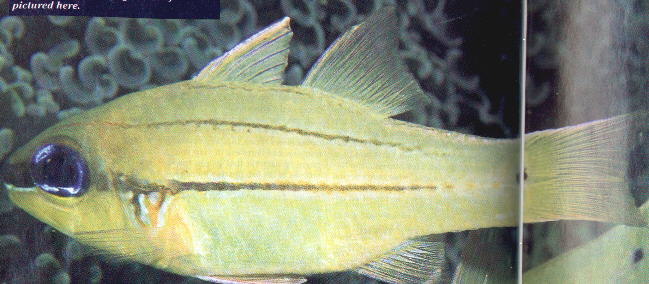

Cardinalfish (Family: Apogonidae) are mostly nocturnal fish that do well in aquariums. They enjoy most small meaty foods, and live foods, but do not care for dry-food like flakes much. Most are hardy and make great specimens for a quiet aquarium or reef tank. They may be bothered by boisterous fish though. Acclimating most is easy, make sure they are eating in the store first, and offer live brine shrimp as a first food. Eventually, they will take a variety of foods. Mysid shrimp would be an excellent choice of food for them if it can be obtained. For the strictly nocturnal species, they may adapt to daytime life, but at first they may have to be fed a half-hour after the tank lights go off to encourage natural feeding, or in the evenings. They frequently move in short spurts. They have two dorsal fins, which is unique, and large eyes, indicating their nocturnal nature. One species occurs in pure freshwater.
Cardinalfish mostly care for their young by Mouthbrooding: raising the fry in their mouth. This is very effective, and allows the fry to be easier to raise than other marine fish since they come out at such a greater size. Indeed, we will soon have to recultivate Banggai with Captive-bred Cardinalfish, as the wild ones will soon be driven to extinction it appears (as countless people warned).
The Banggai Cardinalfish is also called the Banner Cardinalfish, and is native only to a small area around Banggai Island. One reason for such a limited distribution of this species is due to the fact that they are mouthbrooders, and that does not lead too a huge production of fry, nor a huge displacement of fry to other areas like the pelagic fry enjoy. These fish attain a fair size for a Cardinalfish, and can get up to 3.5 inches. They were discovered decades ago, but have only recently been available in the hobby. Due to an incredible exportation rate (10,000 a month at the average sized fishing village there) , this fish is rapidly becoming endangered in the wild. Captive bred stock is available, and should be your only choice in this regard. They show themselves much more in the daytime than other Cardinalfish, and are more active in the daytime as well. “They are found in Sea Grass Beds, and among the spines of large Diadema Sea Urchins.” (1) It is best to have a pair, as if kept in a group, when they mature they will pair up and surely kill the other ones. We were going to write an article on breeding them this month too, but we have not collected enough individuals yet, and therefore do not have the experience needed to go about such at this time. Therefore, we will direct you to links to other articles that deal with the breeding aspects of this wonderful aquarium resident.

The Flame Cardinalfish (Apogon maculatus) is a pretty deep red fish that attains 3-6 inches, usually around 4 in captivity. They come from the Western Atlantic Ocean actually, and like to be kept with quiet fish, as they can be shy. They are nocturnal.
The other most common Cardinalfish in the hobby is the classic Pyjama / Spotted Cardinalfish (Sphaermia nematopterus). We have reason to believe this Latin name may be out of date though. It grows 3-4 inches, and is from the Indo-Pacific region. It is found in small groups usually among SPS coral heads. The Sulawesi Coral Reefs are one home for this fish, and the next one:

Apogon sealei is an attractive Cardinalfish that occurs in pairs among Anchor / Hammer corals. It’s the yellow Cardinal on this page, and the picture was taken by Scott Michael, an excellent aquarist.

The Ring-tailed Cardinalfish is okay looking, but hardy. It is sometimes seen in the trade.
Four articles to consult on the breeding aspects of the Banngai / Banner Cardinalfish:
(1) This quote is from Scott Michaels May 1999 AFM article.
(2) http://www.breeders-registry.gen.ca.us/Articles/v4_i4_marini/marini.htm
(3) http://www.breeders-registry.gen.ca.us/
(4) http://www.reefs.org/library/talklog/f_marini_020799.html
(5) http://www.reefs.org/library/article/f_marini.html
(6) http://www.aquariumfrontiers.com/fish/aqfm/1999/july/eq/default.asp
 A school Of Cardinalfish
A school Of Cardinalfish
One of many common Striped Cardinalfish 